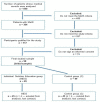Individual Diet Modification Reduces the Metabolic Syndrome in Patients Before Pharmacological Treatment
- PMID: 34205362
- PMCID: PMC8234117
- DOI: 10.3390/nu13062102
Individual Diet Modification Reduces the Metabolic Syndrome in Patients Before Pharmacological Treatment
Abstract
Modification of lifestyle, including healthy nutrition, is the primary approach for metabolic syndrome (MetS) therapy. The aim of this study was to estimate how individual nutrition intervention affects the reduction of MetS components. Subjects diagnosed with MetS were recruited in the Lomza Medical Centre. The study group consisted of 90 participants and was divided into one intervention group (individual nutrition education group (INEG)) and one control group (CG). The research was conducted over 3 months. The following measurements were obtained during the first visit and after completion of the 3 months intervention: body mass, waist circumference, body composition, blood pressure, fasting glucose, and blood lipids. Dietary assessments were performed before and post-intervention using 3-day 24-h dietary recalls. Dietary knowledge was evaluated with the KomPAN questionnaire. The total polyphenol content of the diet was calculated. Sociodemographic and lifestyle characteristics were collected from a self-reported questionnaire. The physical activity was assessed by the short version of the International Physical Activity Questionnaire (IPAQ). It was found that the individual nutrition education was an effective method to improve the knowledge, dietary habits, and physical activity of the study participants. The modification of the diet in terms of higher intake of polyphenols (flavonoids and anthocyanins), fiber, polyunsaturated fatty acids (PUFA), PUFA n-3, and lower intake of saturated fatty acids (SFA) had a significant impact on the improvement of some MetS risk factors (waist circumference, fasting glucose, and HDL-cholesterol).
Keywords: blood pressure; dietary habits; fasting glucose; high-density lipoprotein; polyphenols; triglycerides; waist circumference.
Conflict of interest statement
The authors declare no conflict of interest.
Figures
References
-
- Alberti K.G., Eckel R.H., Grundy S.M., Zimmet P.Z., Cleeman J.I., Donato K.A., Fruchart J.C., James W.P., Loria C.M., Smith S.C., Jr. Harmonizing the metabolic syndrome. A joint interim statement of the International Diabetes Federation Task Force on Epidemiology and Prevention; National Heart, Lung, and Blood Institute; American Heart Association; World Heart Federation; International Atherosclerosis Society; and International Association for the Study of Obesity. Circulation. 2009;120:1640–1645. doi: 10.1161/CIRCULATIONAHA.109.192644. - DOI - PubMed
-
- Scuteri A., Laurent S., Cucca F., Cockcroft J., Cunha P.G., Mañas L.R., Mattace Raso F.U., Muiesan M.L., Ryliškytė L., Rietzschel E., et al. Metabolic Syndrome and Arteries Research (MARE) Consortium. Metabolic syndrome across Europe: Different clusters of risk factors. Eur. J. Prev. Cardiol. 2015;22:486–491. doi: 10.1177/2047487314525529. - DOI - PMC - PubMed
-
- Zujko M.E., Waśkiewicz A., Witkowska A.M., Szcześniewska D., Zdrojewski T., Kozakiewicz K., Drygas W. Dietary total antioxidant capacity and dietary polyphenol intake and prevalence of metabolic syndrome in Polish adults: A nationwide study. Oxid. Med. Cell. Longev. 2018;2018:7487816. doi: 10.1155/2018/7487816. - DOI - PMC - PubMed
MeSH terms
Substances
LinkOut - more resources
Full Text Sources
Medical




